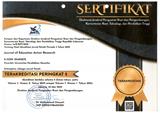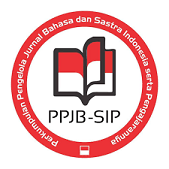Bentuk dan Kesantunan Tindak Tutur Guru dan Siswa pada Kegiatan Belajar Mengajar di Kelas X AK A dan AK B SMK Negeri 1 Singaraja
DOI:
https://doi.org/10.23887/jjpbs.v3i1.5299Abstract
Penelitian ini bertujuan mendeskripsikan 1) bentuk tindak tutur guru pada kegiatan tanya jawab di kelas X AK A dan AK B SMK N 1 Singaraja, 2) bentuk tindak tutur siswa, 3) kesantunan tindak tutur guru, dan 4) kesantunan tindak tutur siswa. Peneliti menggunakan rancangan deskriptif kualitatif dan kuantitatif dengan subjek guru dan siswa kelas X AK A dan AK B SMK N 1 Singaraja. Pengumpulan data dengan metode observasi dan perekaman. Data dianalisis dengan teknik deskriptif. Hasil penelitian: 1) bentuk penggunaan tindak tutur guru terdiri atas tuturan bermodus deklaratif 17 (56,67%) tuturan, bermodus interogatif 5 (16,67%) tuturan, bermodus imperatif 8 (26,66%) tuturan. 2) bentuk penggunaan tindak tutur siswa terdiri atas tuturan bermodus deklaratif 25 (83,33%) tuturan, bermodus interogatif 3 (10%) tuturan, dan bermodus imperatif 2 (6,67%) tuturan. 3) kesantunan tindak tutur guru ditemukan 5 prinsip kesantunan dari 6 prinsip yang ada, yaitu maksim kedermawanan 1 (3.33%) tuturan, maksim penghargaan 12 (40%) tuturan, maksim kesederhanaan 1 (3.33%) tuturan, maksim kemufakatan berjumlah 14 (46,67%) tuturan, dan maksim kesimpatisan 2 (6.67%) tuturan. 4) kesantunan tindak tutur siswa ditemukan 6 prinsip kesantunan dan 4 tuturan yang menyimpang/tidak santun dari prinsip kesantunan, yaitu maksim kebijaksanaan 1 (3,33%) tuturan, maksim kedermawanan 1 (3,33%) tuturan, maksim penghargaan 8 (26,68%) tuturan, maksim kesederhanaan 4 (13,33%) tuturan, maksim kemufakatan 11 (36,67) tuturan, dan maksim kesimpatisan 1 (3,33%) tuturan. Tuturan siswa yang menyimpang/tidak santun dari prinsip kesantunan yaitu 4 (13,33%) tuturan.Kata Kunci : bentuk tindak tutur, kesantunan, tanya jawab
This research aims to describe 1) The form of a speech act of teachers activities in question and answer session in class X AK A and AK B Public Vocational High School 1 Singaraja, 2) The form of a speech act of students, 3)The Modesty of a speech act of teachers, and 3) The Modesty of a speech act of students. The Researcher used qualitative descriptive design and quantitative with the teachers and students classX AK A and AK B Public Vocational High School 1 Singaraja as the subjects. Data collection by the method of observation and recording. Data were analyzed by descriptive technique. The result of the research: 1) the form of the use of a speech act teachers consists of declarative -modus utterance 17 (56,67%) utterances, interrogative-modus 5 (16,67%) utterances, imperative-modus 8 (26,66%) utterances. 2) The form of the use of a speech act of students consists of declarative -modus 25 (83,33%) utterances, interrogative-modus 3 (10%) utterances, and , imperative-modus 2 (6,67%) utterances. 3) The Modesty of a speech act of teachers was found that 5 principles of modesty of 6 available principles, namely maxim of generosity 1 (3.33%) utterances, maxim of appreciation 12 (40%) utterances, maxim of simplicity 1 (3.33%) utterances, maxim of consensus 14 (46,67%) utterances, maxim of sympathy 2 (6.67%) utterances. 4) The Modesty of a speech act of students was found that 6 principles of modesty and 4 utterances that deviating/ immodest of the principles of modesty, namely maxim of wisdom 1 (3,33%) utterances, maxim of generosity 1 (3,33%) utterances, maxim of appreciation 8 (26,68%) utterances, maxim of simplicity 4 (13,33%) utterances, maxim of consensus 11 (36,67) utterances, maxim of sympathy 1(3,33%) utterances. Utterances that deviating/ immodest of the principles of modesty namely 4(13,33%) utterances.
keyword : form of a speech act, modesty , question and answer
Published
2015-07-22
Issue
Section
Articles
License
Authors who publish with the Jurnal Pendidikan Bahasa dan Sastra Indonesia Undiksha agree to the following terms:- Authors retain copyright and grant the journal the right of first publication with the work simultaneously licensed under a Creative Commons Attribution License (CC BY-SA 4.0) that allows others to share the work with an acknowledgment of the work's authorship and initial publication in this journal
- Authors are able to enter into separate, additional contractual arrangements for the non-exclusive distribution of the journal's published version of the work (e.g., post it to an institutional repository or publish it in a book), with an acknowledgment of its initial publication in this journal.
- Authors are permitted and encouraged to post their work online (e.g., in institutional repositories or on their website) prior to and during the submission process, as it can lead to productive exchanges, as well as earlier and greater citation of published work. (See The Effect of Open Access)







